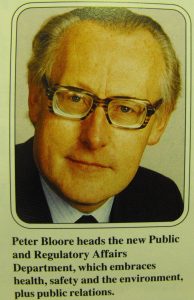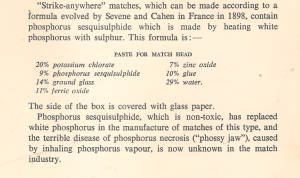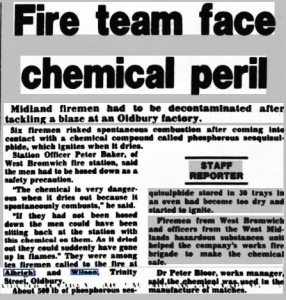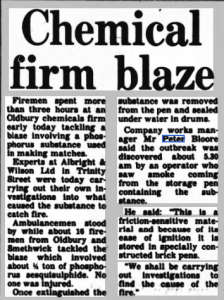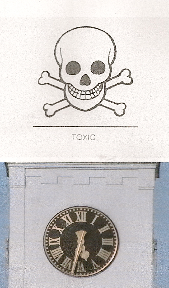
Another tale of failed management, another tale of “Dr” Peter Bloore.
Quite why he was seemingly promoted to the role above in Albright and Wilson due to his absolute failures as works manager at Trinity Street is beyond me, but perhaps he was just so good at lying to the public that they thought he would fit the job.
These two separate incidents , again from his disastrous tenure at the helm as phosphorus commander both deal with a substance known as phosphorus sesquisulphide.
A short history lesson is needed about this substance, chemical formula P4S3, and Albright and Wilson’s manufacture of it, which started in 1898/99.
The dangerous use of white phosphorus matches paved the way for “safer” alternatives, with this yellow solid being one of the most well known. It wasn’t really “safe” because it still could catch fire very easily, due to the impurities of white phosphorus within it when the p4 was heated with sulphur. It’s reaction with water is also dangerous.
From “The manufacture and uses of phosphorus and some of its compounds”, we get the formula for the “strike anywhere” matches that used this chemical at 9%. Don’t try making any fiery explosions at home by following this formula now, yall 😀
This was without doubt a lucrative Albright and Wilson’s export line in the 20th Century. Some studies however by J. FREDERICK BURGESS show how the sesquisulphide of phosphorus can cause series dermatitis issues when handled with these type of match material.
“This poisoning resulted in a recurring severe primary dermatitis about the eyes and face. In each case, loosening of the teeth occurred which may have been due to phosphorus poisoning. In one case a severe systemic poisoning resulted which cleared up completely on discontinuing the use of matches.”
I’d suggest therefore that the term “non-toxic” is therefore another Albright and Wilson semantic argument which could be challenged. When it combusts, it forms sulphur dioxide and also phosphorus pentoxide, which Albright and Wilson have continuously lied about being non-toxic during their frequent off site releases.
As this post also shows, in the latter part of the century, they were still having problems with making it safely at POBox 80.
Two incidents within just a few weeks demonstrate how their farcical health and safety systems were not up to scratch. The first from 24th July 1989 Sandwell Evening Mail tells how firemen tackling a fire had to be “de-contaminated” after coming into contact with a fire involving the substance.
“The chemical is very dangerous when it dries out because it spontaneously combusts”
It is interesting to see that the fire commander also highlights the real prospect of carrying the drying solid off site and the potential for it to catch fire thereafter. The only comment from Dr phosphorus is that it was used in the production of matches- a typical Albright and Wilson Bloore statement which basically reads as an advertisement and never an explanation or apology.
Well strike a light, if the same thing didn’t happen just two months later!
The same paper reported another fire in its September 11th edition. On this occasion, firemen spent 3 hours putting that light out. A large amount of the substance had again caught fire, and one can only deduce from this is that it was not being stored safely.
Bloore promised an investigation, like these people always do, but the paper failed to link these two close incidents which is poor journalism to be honest. Whatever this “investigation” amounted to, the method of disposing of the mess would not be investigated. It was simply drummed up for disposal.
The statement about storing it in water appears to very dubious as this chemical produces toxic gases when doing so. We do know however that their Gower Tip licence SL32 allowed them to dispose of 2 tonnes a year of this substance at this site, as well as the linked phosphorus pentasulphide, and this tip was still in use at the time of this fire, indeed, the same firemen would be tackling a fire next to the Gower in the following year. and expressing concern at the exposed drums of chemicals dumped there 😆
The main problem with phosphorus pentasulphide and sesquisulphide at this very “hazardous landfill” waste site is revealed in the waste management licence report to the former West Midlands County council who granted this “contentious licence” insanity back in 1978.
“I Background
This site is a former clay marl hole which has been used as an industrial tip since 1938. The site has received large quantities of toxic and hazardous waste since this time. These are mostly comprised of various compounds of phosphorus together with some radio-active wastes, laboratory chemicals, solvents etc. The site represents the major disposal outlet for the Company’s waste phosphorus pentasulphide and phosphorus susquisulphide.(sic)
These waste arisings are the main problem associated with this site since they are highly reactive especially with water. “
Of course, “the stuff used in matches” at The Gower tip remains buried there to this day.

